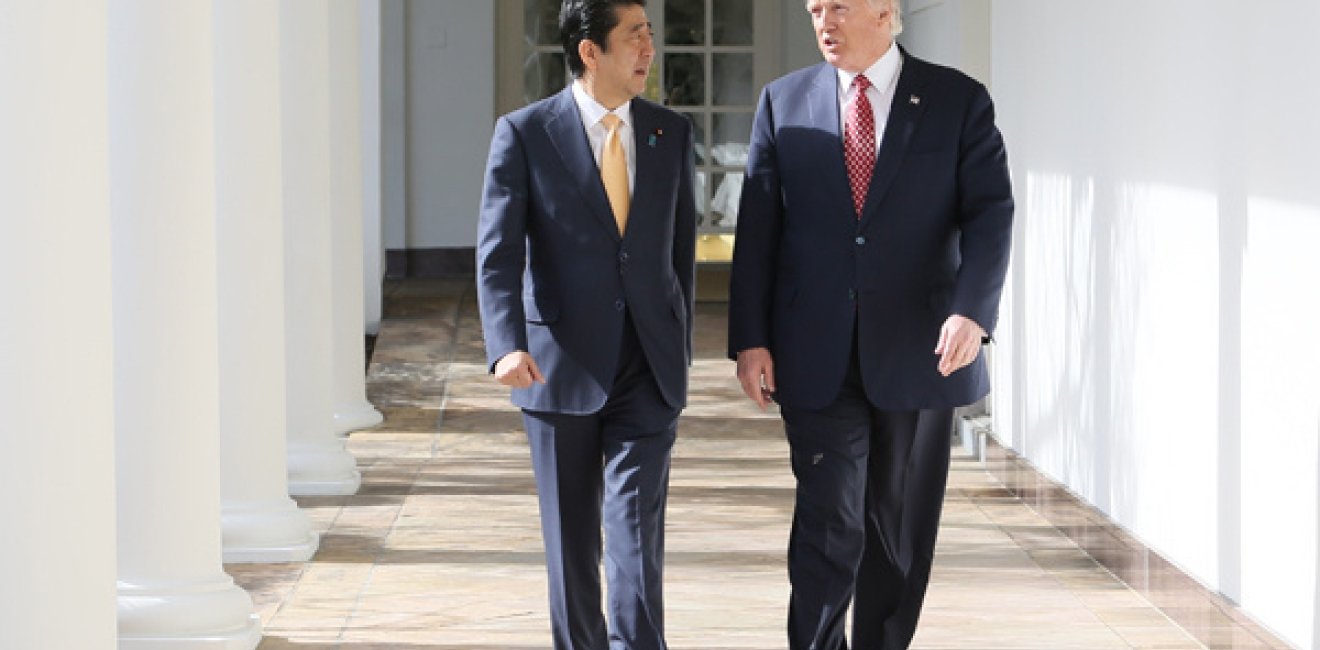
A blog of the Indo-Pacific Program
As Japanese Prime Minister Shinzo Abe prepares to visit Washington later this month, it’s clear that his upcoming meeting with President Trump won’t be an easy one, to say the least. At his previous meetings with the U.S. president, issues of potential conflict were averted to concentrate instead on the positive relationship. This time around, though, conflict will be inevitable since there will be a number of must-gets by Abe in order for the talks to be deemed as a success. Being seen as a leader who can actually achieve results will be crucial for the prime minister at a time when his political standing back home is increasingly on shaky ground. At the same time, the Trump administration’s protectionist policies to increase trade barriers in hopes of reducing deficits is making the rest of the world, including Japan, increasingly on edge.
There is mounting frustration in Japan in particular that while Abe has seemingly had good personal relations with the president, that rapport has meant very little in the end. In fact, as Tokyo plans for Abe’s fourth face-to-face meeting with Trump from April 17 to 18 at Mar A Lago, doubts about Japan’s ability to tap into the camaraderie that the prime minister has tried hard to cultivate since Trump’s unexpected election victory, continue to rise. There is a growing sense of betrayal by the United States in Tokyo, and the challenge for Abe will be nothing less than to reverse that sentiment.
At the top of the prime minister’s must-have list is above all else to get Japan exempted from the steel and aluminum tariffs that were introduced by the administration late last month, ostensibly in the name of national security. All major U.S. allies including the European Union, South Korea, Mexico, and Canada, however, were exempted from the 25 percent tariff on steel and 10 percent levied on aluminum. The only glaring exception is Japan, much to Tokyo’s chagrin.
Japan had firmly believed it too would be exempted, especially when Canada is by far the single biggest exporter of steel and aluminum to the United States while Japan only ranks in at seventh place, accounting for less than 5 percent of the total. In announcing the tariffs, Trump stated that “people have no idea how badly our country has been treated by other countries,” arguing that it was trade that destroyed the U.S. steel and aluminum sectors.
Such sentiment of victimhood reflects more of the attitude that was pervasive in the 1980s and 1990s, when Japanese exports flooded the United States while Japanese companies gobbled up prize U.S. assets including Rockefeller Center and Pebble Beach golf course.
But the realities and sentiments since the height of the U.S.-Japan trade wars have shifted considerably since. Certainly, Japan has highlighted the role its foreign direct investment into the United States plays in supporting the U.S. economy, and the Abe government has made a concerted effort to discuss opportunities to work together with the Trump administration to enhance U.S. growth prospects, especially in infrastructure development.
Still, the current U.S. trade negotiating team is likely to turn more towards the approach Washington had three decades ago, especially with USTR being led by Robert Lighthizer, who was deputy USTR representative under President Reagan. At the same time, the re-emergence of Peter Navarro as a key player in setting the U.S. economic agenda is likely to increase a more combative attitude towards Japan by focusing on the U.S. goods trade deficit with the country to the tune of $69 billion.
The divide in how the two countries view trade relations is undoubtedly becoming more marked. While Tokyo has focused on keeping the multilateral Trans-Pacific Partnership alive even without the United States and has emerged as a champion for the free trade agreement, Washington now remains more intent on taking protectionist action and building trade barriers. When it does move towards trade deals, it unwittingly favors bilateral agreements to reduce its deficits in goods with specific countries.
As such, there is growing speculation that the Trump administration will be pushing for a bilateral trade deal with Japan as Tokyo tries hard to get exempted from the steel and aluminum tariffs. Failing to be exempted outright, Japan’s strategy will likely be to negotiate for exemptions on specific categories of products. What is clear, though, is that whatever personal relations Abe may have enjoyed with Trump on the golf course, that has not led to concrete results to strengthen the prime minister’s position to date. Given that Abe is one of the longest-serving leaders at a time of global uncertainty, how he will navigate the summit meeting without hurting his position will have repercussions beyond Japan’s borders.
Image: Government of Japan
The views expressed are the author's alone, and do not represent the views of the U.S. Government or the Wilson Center. Copyright 2018, Asia Program. All rights reserved.
Author


Indo-Pacific Program
The Indo-Pacific Program promotes policy debate and intellectual discussions on US interests in the Asia-Pacific as well as political, economic, security, and social issues relating to the world’s most populous and economically dynamic region. Read more





